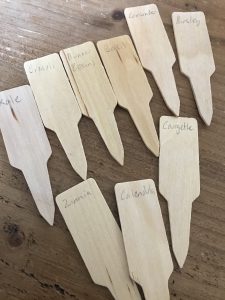The Reluctant Grower

So I will be honest. The above shows the state of my vegetable patch. Despite working professionally as a gardener, I specialise in ornamental plants and I am a reluctant grower. Those who know me will often have heard me cast doubt as to whether growing your own veg is really worthwhile unless you are a household of 4 or more. The outlay can be more than you would expect and the time and motivation to tend your plot can be hard to find. You often produce a large amount of one crop, which is impossible for two people to get through. There will be those of you reading this, however, who already know of the pleasure that comes from “magically” creating food from a seed and the ground. Others will also testify to the satisfaction and health benefits of getting something so worthwhile out of a physically activity which also helps keep you fit. Really there is no reason not to grow if you are able to.
I am therefore not an expert on growing vegetables, but I felt an urge to include this in my blog and get my thoughts out to you. Without mentioning the “C-word”, it is the case that many of us will find we are using our time differently in the coming months, whether because of self isolation, working from home, being unable to work or laid off, or because social life has also been curtailed. So finding a way to grow some plants could be a great thing to do on many levels. If you don’t have a garden but have outside space, you could find a few larger pots or planters (I will be using some old wooden boxes from my boss), or even just use multipurpose compost in the bag it came in – like a Growbag. If you have no outside space at all, you could still try growing a few smaller plants (like chillies, herbs, tomatoes) on your windowsill.

So step one for me is just to get started. A few weeks ago we put cardboard down over the overgrown parts of the patch. This will exclude light and therefore start to weaken and kill off the grass underneath. If we had the resources and access, a simple “no dig” method would now be to order a bulk load of compost and cover the cardboard to a depth of about 4-6 inches. You could then start to plant into that compost, and the plants’ roots would fairly quickly find their way through the compost and decaying cardboard and into the ground below.
However we can only reach our plot through a narrow passageway and over a couple of steps, so getting that amount of compost in without a vehicle would be difficult. Instead, I will be waiting until the grass is weaker and doing some hard work, digging and cutting through the top layer of grass and weeds, working it with a fork and removing the old vegetation until I have clearer soil to plant in.
Although spring is already upon us, it has been a delayed start. After a mild winter, we had a cold and wet February and March. Many plants have been slow to get going, and this is now an advantage if you are sowing things a bit late. It is now a good time to get a few crops direct into the ground – like potatoes, peas, broad beans and some salad crops. In a few weeks you could start with beetroot, radishes etc. You can also start other crops on a windowsill indoors – things like beans, courgettes, chillies, tomatoes.

At time of writing, we were still able to go out to the garden centre to buy supplies (and hopefully these businesses will find a way to stay open). So if you are able, then you could go out and get some stock to get you going. I would recommend some of the veg I have mentioned above and also adding some flowers from seed, such as sunflowers, poppies and marigolds. If you are worried about growing from seed or know you will only want to grow a few plants you could also buy your veg as small, ready grown plants (often called plugs).

A couple of bags of multipurpose compost will always be useful to have (for example for using in pots which you are using to start seeds off, or to add to holes in the plot when planting, which will loosen the existing soil and add nutrition. You may also want to consider some poles or supports (for example if you are growing runner beans) and a fertiliser that is suitable for vegetable crops (especially if you are growing in pots or planters). Your veg will ideally want some extra nutrients to grow healthily.
If you can’t get out for supplies, try connecting with neighbours or try finding a way to seed swap with other people locally. Many people won’t use all the seeds they buy so this is a great way to avoid wasting them.
The packets of seeds you buy will have instructions on them about how to grow. I would recommend reading these before you buy to check they make sense, and that you are buying something to sow at the right time of year. You can also find lots of great online tutorials (eg via the RHS – https://www.rhs.org.uk/advice/grow-your-own).
Good luck and I will include a few updates on my vegetable growing in the coming months. I will also be talking about general garden care – as usual.
